







As an industry, we have committed to reaching net-zero carbon emissions by 2050. With customers seeing a 15 to 20+% reduction in CO2 emissions*, the LEAP engine family is a clear choice today for a more sustainable tomorrow. Extraordinary together.
 CFM International is a 50/50 joint company between GE and Safran Aircraft Engines *Compared to previous generation engines.
cfmaeroengines.com/sustainability
CFM International is a 50/50 joint company between GE and Safran Aircraft Engines *Compared to previous generation engines.
cfmaeroengines.com/sustainability
Publisher And editor-in-Chief
Jayant Baranwal
dePuty MAnAging editor
Neetu Dhulia
PrinCiPAl CorresPondent
Ayushee Chaudhary
Contributors
India:
Air Marshal Anil Chopra (Retd)
Group Captain Joseph Noronha (Retd)
Europe: Alan Peaford
USA & Canada: LeRoy Cook
ChAirMAn & MAnAging direCtor
Jayant Baranwal

PlAnning & business develoPMent
Executive Vice President: Rohit Goel
MAnAger – hr & AdMin
Bharti Sharma
dePuty MAnAger – CirCulAtion
Rimpy Nischal
grouP reseArCh AssoCiAte
Survi Massey
reseArCh AssistAnt
Sarthak Baranwal design
Holistic Directions: Jayant Baranwal
Sr. Designer: Vimlesh Kumar Yadav, Designer: Sonu S. Bisht
grouP direCtor – sAles & MArketing
Neetu Dhulia
dePuty direCtor – sAles
Rajeev Chugh
sP’s websites
Sr Web Developer: Shailendra P. Ashish
Web Developer: Ugrashen Vishwakarma
© SP Guide Publications, 2023
Subscription/Circulation
Annual Inland: `1,200 • Foreign: US$320
E-mail: subscribe@spguidepublications.com subscribe@sps-aviation.com
LETTER TO EDITOR editor@sps-aviation.com; expert@sps-aviation.com
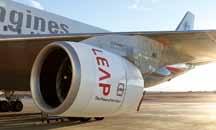
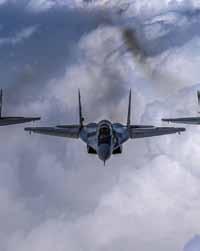
For Advertising details, contact: neetu@spguidepublications.com rajeev.chugh@spguidepublications.com
SP GUIDE PUBLICATIONS PVT LTD
A-133 Arjun Nagar, (Opposite Defence Colony) New Delhi 110003, India.
Tel: +91 (11) 24644693, 24644763, 24658322
Fax: +91 (11) 24647093
E-mail: info@spguidepublications.com
Representative Office
MOSCOW, RUSSIA
LAGUK Co., Ltd., (Yuri Laskin)
Krasnokholmskaya, Nab.
11/15, app. 132, Moscow 115172, Russia.

Tel: +7 (495) 911 2762
Fax: +7 (495) 912 1260
MEMBER / PARTNER OF
India celebrated its 74th republic day on January 26 this year with great spirit and fervour! The occasion was marked by a spectacular air display with 50 aircraft and helicopters of the three forces - Air, Navy, and Army. This included 45 aircraft of the Air Force, one from the Navy, and four helicopters of the Army exhibiting their professional flying skills. Inside this issue, we have a compilation of the aircraft during the flypast showing the various formations in which they flew.
Technological advancements in design, structure, features as well as capabilities are speedily transforming the future of the aerospace and defence industry. This edition looks at some of those new launches and training methods on the technology side of the industry. For instance, Northrop Grumman and the US Air Force unveiled the B-21 Raider, the first new, long-range strike bomber in a generation and an aircraft specifically designed to be the multifunctional backbone of the modernised bomber fleet. While the B-21 isn’t expected to be operational and introduced into service for several more years, the formal unveiling ceremony is a significant milestone in the US Air Force’s effort to modernise combat capabilities. A detailed report on the same by Rohit Goel is part of this issue. This edition also looks at Embraer’s military force multiplier, the C-390 Millenium and the KC-390 variant in a report by Ayushee Chaudhary. Continuing the military fervour, Group Captain D.K. Pandey (Retd) analyses China and Pakistan’s “Joint Fighter-17” (JF-17). The single-engine, multi-role fighter of Pakistan Air Force (PAF) is looking for buyers. He looks at some false claims, issues with PAF JF-17, the impact of Russia-Ukraine war and the anticipated capabilities of the modernisation programme.
In another article Air Vice Marshal Sanjay Bhatnagar (Retd) looks at some of the critical deficiencies with IAF and the need to develop the capability to fight and win tomorrow’s wars, highlighting that multi-domain operations and hybrid warfare are here to stay, as indicated by the Chief of the Air
Staff as well. This edition also looks back at the first supersonic aircraft, the Bell X-1.
Touching upon technological training, Air Marshal Sukhchain Singh (Retd) writes about simulator technology that is advancing particularly in computer technology during the last twenty years, majorly impacting flight simulation. Looking at flight simulators for commercial as well as business aircraft, this issue of the magazine also states the growing demand for simulators that can be re-configured or possibly be upgraded to support newer aircraft models. Another article by Rohit Goel underlines some of the leading flight simulators for commercial and general aviation along with the need to make training more efficient for the younger pilots growing up in a digital age.
This edition also covers a detailed report on CFM LEAP Family by Joseph Noronha. Looking at the LEAP engine’s journey, he highlights that within a short span of time LEAP has become the second most ordered jet engine ever, lagging only its predecessor, the CFM56.
All this and more in this issue of SP’s Aviation. Welcome aboard and we wish you many happy landings!
Jayant Baranwal
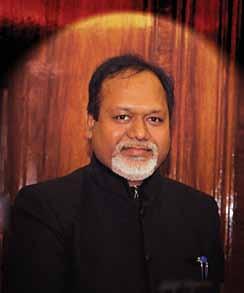
Advancement is key; be it technology, regulations, capabilities and contacts. The grand Republic Day Parade, held this year, also promoted advancement in local defence manufacturing by displaying only ‘Made-in-India’ weapon systems.
Publisher & e ditor-in-Chief
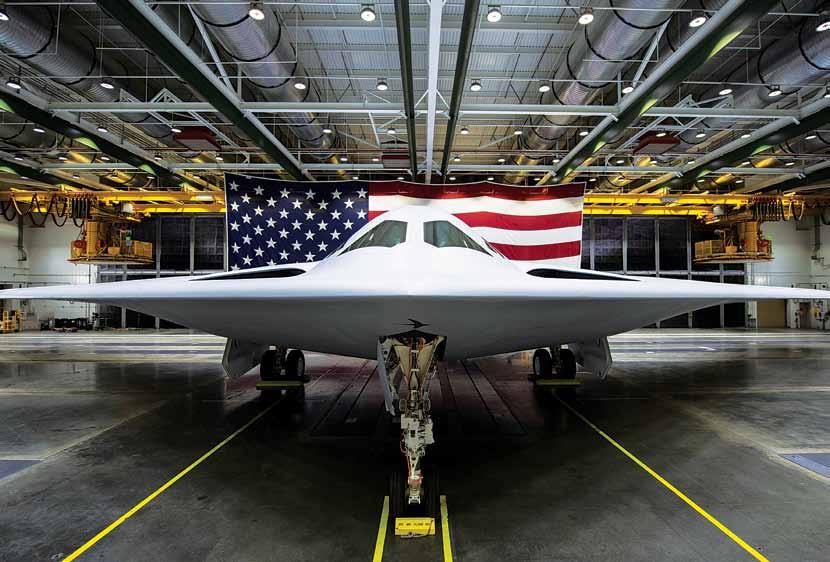 By Rohit Goel
By Rohit Goel
northrop grumman and the US Air Force unveiled the B-21 Raider to the world on December 2, 2022. The B-21 joins the nuclear triad as a visible and flexible deterrent designed for the US Air Force to meet its most complex missions. It is the first new, long-range strike bomber in a generation and an
aircraft specifically designed to be the multifunctional backbone of the modernised bomber fleet.
While the B-21 isn’t expected to be operational and introduced into service for several more years, the formal unveiling ceremony hosted by Northrop Grumman Corporation at its
production facilities in California is a significant milestone in the US Air Force’s effort to modernise combat capabilities. The B-21 is designed to be a more capable and adaptable, state-ofthe-art aircraft that will gradually replace aging B-1 Lancer and B-2 Spirit bombers now in service.
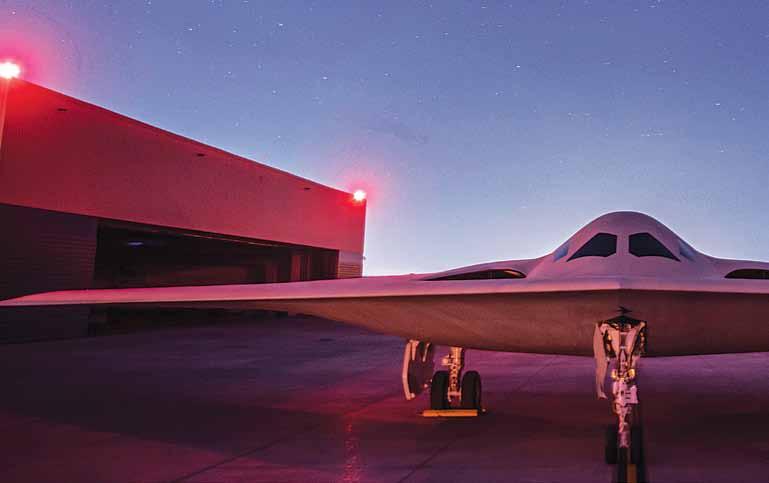
“The Northrop Grumman team develops and delivers technology that advances science, looks into the future and brings it to the here and now,” said Kathy Warden, Chair, Chief Executive Officer and President, Northrop Grumman. “The B-21 Raider defines a new era in technology and strengthens America’s role of delivering peace through deterrence.”
The B-21 Raider forms the backbone of the future for US air power, leading a powerful family of systems that deliver a new era of capability and flexibility through advanced integration of data, sensors and weapons. According to design requirements, the B-21 is a long-range, highly survivable stealth bomber capable of delivering a mix of conventional and nuclear munitions. Its sixth-generation capabilities include stealth, information advantage and open architecture.
“The B-21 Raider is the first strategic bomber in more than three decades. It is a testament to America’s enduring advantages in ingenuity and innovation. And it is proof of the Department’s long-term commitment to building advanced capabilities that will fortify America’s ability to deter aggression, today and into the future. Now, strengthening and sustaining US deterrence is at the heart of our National Defence Strategy,” said Sec-
retary of Defence Lloyd J. Austin III. “This bomber was built on a foundation of strong, bipartisan support in Congress. And because of that support, we will soon fly this aircraft, test it and then move into production.”
“With the B-21, the US Air Force will be able to deter or defeat threats anywhere in the world,” said Tom Jones, Corporate Vice President and President, Northrop Grumman Aeronautics Systems. “The B-21 exemplifies how Northrop Grumman is leading the industry in digital transformation and digital engineering, ultimately delivering more value to our customers.”
The B-21 is capable of networking across the battlespace to multiple systems, and into all domains. Supported by a digital ecosystem throughout its lifecycle, the B-21 can quickly evolve through rapid technology upgrades that provide new capabilities to outpace future threats.
“Leveraging innovative manufacturing techniques, open systems architectures and active management allows us to integrate new technology as it matures and ensures the B-21 can adapt to future threats and be successful when and where we need it,” Assistant Secretary of the Air Force for Acquisition, Technology and Logistics Andrew P. Hunter, said.
When delivered to the Air Force, the B-21 will join the nation’s strategic triad as a visible and flexible deterrent; supporting national security objectives and assuring the nation’s allies and partners. The Raider will provide the Air Force with long range, high survivability and mission payload flexibility.
The B-21 will penetrate the toughest defences for precision strikes anywhere in the world. Here are some key facts about Northrop Grumman’s B-21 Raider.
Sixth Generation. The B-21 Raider benefits from more than three decades of strike and stealth technology. It is the next evolution of the Air Force strategic bomber fleet. Developed with the next generation of stealth technology, advanced networking capabilities and an open systems architecture, the B-21 is optimised for the high-end threat environment. It will play a critical role in helping the Air Force meet its most complex missions.
Stealth. Northrop Grumman is continuously advancing technology, employing new manufacturing techniques and materials to ensure the B-21 will defeat the anti-access, areadenial systems it will face.
Backbone of the Fleet. The B-21 Raider forms the backbone of the future for US air power. The B-21 will deliver a new era of capability and flexibility through advanced integration of data, sensors and weapons. Capable of delivering both conventional and nuclear payloads, the B-21 will be one of the most effective aircraft in the sky, with the ability to use a broad mix of stand-off and direct attack munitions.
A Digital Bomber. The B-21 is a digital bomber. Northrop Grumman uses agile software development, advanced manufacturing techniques and digital engineering tools to help mitigate production risk on the B-21 programme and enable modern sustainment practices. Six B-21 Raiders are in various
stages of final assembly and test at Northrop Grumman’s plant in Palmdale, California.
Cloud Technology. Northrop Grumman and the Air Force successfully demonstrated the migration of B-21 ground systems data to a cloud environment. This demonstration included the development, deployment and test of B-21 data, including the B-21 digital twin, that will support B-21 operations and sustainment. This robust cloud-based digital infrastructure will result in a more maintainable and sustainable aircraft with lower-cost infrastructure.
Open Architecture. To meet the evolving threat environment, the B-21 has been designed from day one for rapid upgradeability. Unlike earlier generation aircraft, the B-21 will not undergo block upgrades. New technology, capabilities and weapons will be seamlessly incorporated through agile software upgrades and built-in hardware flexibility. This will ensure the B-21 Raider can continuously meet the evolving threat head on for decades to come.
A National Team. Since contract award in 2015, Northrop Grumman has assembled a nationwide team to design, test and build the world’s most advanced strike aircraft. The B-21 team includes more than 8,000 people from Northrop Grumman, industry partners and the Air Force. The team consists of more than 400 suppliers across 40 states.
Sustainment. Long-term operations and sustainment affordability has been a B-21 programme priority from the start. In partnership with the Air Force, Northrop Grumman team has made maintainability an equally important requirement to stealth performance to ensure we’re driving more affordable, predictable operations and sustainment outcomes.
Global Reach. The B-21 Raider will be the backbone of the US bomber fleet and pivotal to supporting US strategic deterrence strategy. In addition to its advanced long-range precision strike capabilities that will afford Combatant Commanders the ability to hold any target, anywhere in the world at risk, it has also been designed as the lead component of a larger family of systems that will deliver intelligence, surveillance and reconnaissance, electronic attack and multi-domain networking capabilities. In a dynamic global security environment, the B-21 will provide the flexibility and deterrence critical to the security of the US and its allies.
The B-21 Raider is named in honour of the Doolittle Raid of World War II when 80 airmen, led by Lt. Col. James “Jimmy” Doolittle, and 16 B-25 Mitchell medium bombers set off on a mission that changed the course of World War II. The actions of these 80 volunteers were instrumental in shifting momentum in the Pacific theatre. This marked the raid as a catalyst to a multitude of future progress in US air superiority from land or sea. The courageous spirit of the Doolittle Raiders is the inspiration behind the name of the B-21 Raider. The designation B-21 recognises the Raider as the first bomber of the 21st century.
The specific B-21 unveiled on December 2, 2022 is one of six under production. Each is considered a test aircraft, but each is being built on the same production line, using the same tools, processes, and technicians who will build production aircraft. This approach has enabled production engineers and technicians to capture lessons learned and apply them directly to follow-on aircraft, driving home a focus on repeatability, producibility and quality. The timing for first flight will be data and event, not date driven and hence the precise date when the B-21 will enter service is not known as yet.
The B-21 is the first new bomber to be introduced since the end of the Cold War. Air Force officials envision an ultimate fleet of at least 100 aircraft with an average procurement unit cost requirement of $692 million (base year 2022 dollars). SP
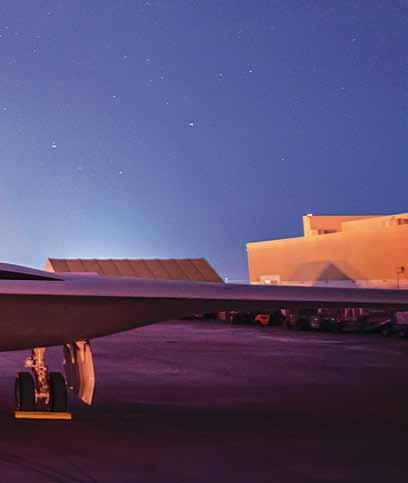
There is a growing demand for simulators for commercial, business and regional aircraft, which enable real-life scenario, which can be re-configured or possibly be upgraded to support newer aircraft models and the focus on manufacturing such simulators will drive the growth of the players
 By Air MArshAll sukhchAin singh (retd)
By Air MArshAll sukhchAin singh (retd)
The procurement of new aircraft for both commercial and general aviation has seen a growing worldwide pilot demand, which, in turn, has led to the high demand for training aircraft and simulators in flight schools. Although the pandemic had resulted in a drop-in pilot demand, the long-term demand for commercial aircraft pilots remains strong. Many airlines are presently facing pilot shortage, which are affecting their daily operations. The unavailability of trained pilots to cater to the ever-growing demand will generate demand for pilot training globally. Though the COVID-19 pandemic resulted in pilot furloughing in 2020 and 2021, airlines are now focusing on long-term growth strategies and have re-started collaborating with pilot training schools to obtain airline-specific training for the pilots. The civil aviation flight training and simulation market is projected to register a CAGR of over 15 per cent during the forecast period (2022-2027).
The civil aviation flight training and simulation market is moderately fragmented. Leading simulator manufacturer CAE Inc is the global market leader, mainly due to its huge geographical presence and brand image. L3Harris Technologies, TRU Simulation + Training Inc. and FlightSafety International are some of the other prominent players in the market. Simulation & training providers and equipment manufacturers constantly strive to build brand reputation and reach out to across the globe to draw more customers. Flight schools are looking for long-term collaborations with airlines and aircraft operators for pilot training programmes, which may help them generate sustainable revenues for longer durations.
Full Flight Simulator (FFS) replicates a specific type, make, model, or series aircraft. It includes the equipment and computer programmes necessary to represent aircraft operations in ground and flight conditions, a visual system providing an out-of-the-flight deck view, a system that provides cues at leaste quivalent to those of a threedegree-of-freedom motion system, and has the full range of capabilities of the systems installed in the device and the QPS for a specific FFS qualification level (Level A, B, C or D).
Flight Training Device (FTD) replicates aircraft instruments, equipment, panels, and controls in an open flight deck area or an enclosed aircraft flight deck replica. It includes the equipment and computer programmes necessary to represent aircraft (or set of aircraft) operations inground and flight conditions having the full range of capabilities of the systems installed in the device and the qualification performance standard (QPS) for aspecific FTD qualification level (Level 4, 5 or 6).
Both the FAA and EASA utilise the term FTD to classify certain flight training devices other than FFS’s. EASA has a further classification referred to as an refer to Flight & Navigation Procedures Trainer (FNPT). An example difference between an FTD and FNPT under EASA is an FTD requires a fully enclosed flight deck, whereas a FNPT does not. FAA & EASA FTD “Levels” are not the same.
Flight Training Devices qualification levels:
• EASA FTD Level 1: May lack a visual system, compared to FNPT the aircraft systems must operate correctly based only on pilot inputs without requiring instructor actions
• EASA FTD Level 2: Visual system with different conditions, cockpit must include other crew stations, controls must replicate movement dynamics.
• EASA FTD Level 3 helicopter only: Model data must be based on validation flights - cannot be generic aerodynamical model, wider field of view.
Full Flight Simulators qualification levels:
• EASA FFS Level A: Motion system with 3 degrees of freedom (pitch, roll, heave).
• EASA FFS Level B: Motion system with all 6 degrees of freedom, modelling ground handling.
• EASA FFS Level C: Simulate different runway conditions, icing, more detailed aerodynamic model.
• EASA FFS Level D: Characteristic vibrations that can be felt in the cockpit, realistic noise levels.
In India DGCA permits usage of aircraft flight simulators for various training purposes offlight crew such as initial, refresher, recurrent, transition, up-grade and others, which may be given credit towards the flight training requirements for issue and renewal of flight crew licenses, endorsements and ratings. It is, therefore, necessary that performance of the simulators be evaluated prior to the approval for use. Also, it is essential that the Simulators and Synthetic Flight Training Devices be maintained to the performance level for which they have been certified.
The major part of Airline Transport Pilot Licence (ATPL) training for airlines is centred on flight simulation. Flight crews undergo checks every six months, which are based on the operational conditions that crews are likely to encounter. They are able to practice emergency drills, subjected to aircraft malfunctions and extreme weather conditions and become familiarised with company routes and operating procedures. The equipment in the simulator is identical, in all aspects, to the equipment on the aircraft, including flight management systems, displays and avionics. The level of fidelity currently achieved in terms of the aircraft dynamics, motion systems and visual system is remarkable. In effect, flight simulation offers a way to provide flight conditions and situations, which enable flight crews to compress experience into a relatively short time frame. For example, flight crews can experience icing conditions in a simulator that they might otherwise only encounter once in five years. These simulators are closely regulated by both the airlines and the regulatory authorities, to ensure that the fidelity conforms to the international standards that have been devised for civil airlines.
Simulator Technology Advances particularly in computer technology during the last twenty years has a major impact in flight simulation. The computations in real-time modelling and visual systems require fast processing. Just five years ago, the processing demands of a flight simulator was possible by workstations or mini computers. Nowadays, the power of an office PC is sufficient to implement complex flight models at update rates in excess of 50 Hz. Similarly, fully textured real-time visual systems have
Simulator Technology Advances particularly in computer technology during the last twenty years has a major impact in flight simulation
been demonstrated on single card PC visual systems with update rates in excess of 30 Hz. In recent years, flight simulation applications have exploited the chipsets developed for domestic markets to achieve the levels of arithmetic processing required for visual systems, which had previously been implemented with specialpurpose hardware. For airline simulators, the high-performance image generation systems and their associated projection systems have been the dominant cost. However, the cost of image generation systems has dropped dramatically; the level of visual fidelity afforded by a visual system is now available from PC cards.
Information compiled based on sources shows that close to 1,500 commercial aircraft simulation devices are currently in use globally. 74 per cent are full-flight simulators and the balance are fixed-based flight training devices. Just over half of all simulation devices were designed for narrow-body aircraft, while widebody and regional jets count for 30 per cent and 11 per cent, respectively. The remaining simulators were built for turboprop types.The flight simulator market is likely to record a CAGR of five per cent through 2032.
CAE has provided more than half of all devices and as a training provider globally, it operates 13 per cent of all simulators in service. The flight simulator market is moving towards consolidation, as major players are actively involved in strategic mergers and acquisitions. Integration of advanced

technologies such as Augmented Reality (AR), Virtual Reality (VR), and Artificial Intelligence (AI) to create enhanced pilot training environments is a key product differentiation strategy adopted by many players. For instance, CAE has installed an inhouse Research and Development department that dedicatedly works for leveraging technologies that enhance flight simulator training environments.The CAE 7000XR Series full-flight simulator (FFS) meet specific requirements of operators and Level D regulatory requirements. CAE’s FFS are recognised as the “gold standard” for their high fidelity and reliability.
CAE has a significant presence in India serving both the defence and civil aviation markets. It had acquired Macmet Technologies in 2007 (now CAE India Private Limited), the leading simulation and training company in Bengaluru, India. CAE Simulation Technologies established in Bengaluru, is a company specialised in software development for the simulation industry worldwide. Also, a joint venture called the Helicopter Academy to Train by Simulation of Flying (HATSOFF), which is equally-owned by Hindustan Aeronautics Limited (HAL) and CAE, to train military and civilian helicopter pilots. CAE Rossell, is a joint venture company owned 74 per cent by Rossell India Ltd and 26 per cent by CAE to provide synthetic training solutions for the Indian defencemarket while meeting offset criteria for Indian defence programmes. It has developed India’s first independent commercial pilot training centre in Bengaluru to train Airbus A320 and Boeing 737 airline pilots. In partner-
Flight simulation offers a way to provide flight conditions and situations, which enable flight crews to compress experience into a relatively short time frame
ship with the Ministry of Civil Aviation and Airports Authority of India (AAI) has established the CAE Oxford Aviation Academy Gondia for ab initio pilot training and managing CAE Oxford Aviation Academy Rae Bareli on behalf of the Ministry of Civil Aviation. Launched in 2013, CAE Simulation Training Pvt Ltd (CSTPL) is a joint venture between InterGlobe Enterprises (IGE) and CAE Inc. It is one of the largest state-of-the-art pilot training facilities in India, where aspirants can benefit from advanced training technology and experienced pilots can get their licenses renewed.
Flight Simulation Technique Centre (FSTC) is the most advanced Full Flight Simulation training company in India today. It is India’s first standalone Approved Training Organisation (ATO) by DGCA and the only approved ATO by European Aviation Safety Agency (EASA). FSTC today has various simulator types to fulfil the diverse requirements of majority of the airlines in India and adjoining region. The centre has eight fully operational level D simulators and functions from two locations within the country, Gurugram and Hyderabad.
Also, FSTC flying school at Bhiwani & Narnaul Haryana provides the capability for end-to-end high-quality training right from Commercial pilot license (CPL) followed by Type rating on a specific fleet type from among A320/ B737/ ATR 72-600/ Bombardier Dash-8 Q400. Also, as a rule, Airline operators having more than 20 aircraft of one type should compulsorily have simulator training facility, owned/leased simulator within India, as per directive of the aviation watchdog Directorate General of Civil Aviation (DGCA). This was as applicable to Indian aviation way back as December 31, 2018, for that type.
Simulators are certified by aviation authorities according to the capabilities and functionality of the device and the purpose for
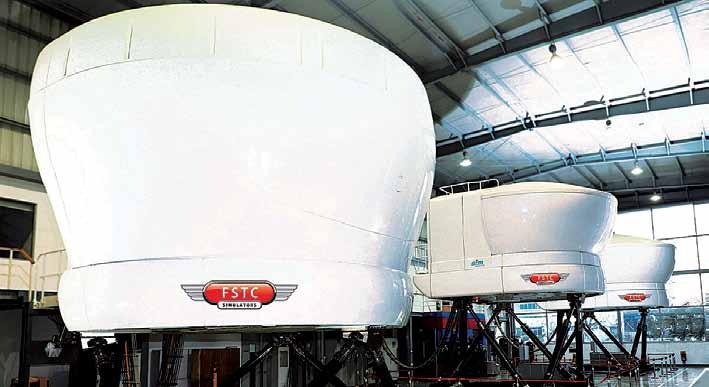
which it is intended. In order to qualify for use in a given area, level or stage of pilot training, the device in question needs to conform to the requirements specified by the relevant aviation authority. Simulators to be used for flight crew training must have a valid FSTD (Flight Simulation Training Device) qualification certificate issued by the competent authority. In order to achieve the FSTD rating, simulators must meet a number of very specific conditions. Among them, they must faithfully emulate the behaviour, reactions and performance of the aircraft they simulate. The certification process lasts for the entire manufacturing process of the simulator. At each stage, the necessary documents are generated in order to be accredited. User manuals, procedures manuals and software and equipment version control manuals are generated. The end of the process is the creation of the QTG (Qualification Test Guides) where the technical characteristics of the simulator are specified, how it is tested and checked for correct operation. Once the simulator has undergone objective testing, the regulatory organisation certifies that the simulator complies with the design and performance standards that resemble the aircraft it simulates. Simulators are certified on a model-bymodel basis once installed and operating at the operator’s location. In case of a change of location they must be recertified after relocation. Certifications are renewed periodically.
Scheduled surveillance checks and surprise audits are regularly done by the regulator. These are to find inefficiencies in the safety system of airlines, airports, flying training organisations and simulators and implement corrective measures. The Directorate General of Civil Aviation (DGCA) in May 2021 had imposed a `10-lakh fine on an airline for training 737 MAX aircraft’s pilots on a faulty simulator. Earlier, the DGCA had barred 90 pilots of the same airline from flying B737 MAX aircraft and they had to be retrained. SP
Modern full-flight simulators are so realistic that a student pilot can learn to fly from scratch in the virtual world and step directly into an aircraft for real-world, leave-theground checkout flights.
A flight simulator is any device that recreates the environment of flying an aircraft. Full Flight Simulators (FFS) replicate a specific type, make, model, or series of aircraft. It includes the equipment and computer programs necessary to represent aircraft operations in ground and flight conditions, a visual system providing an out-of-the-flight deck view and has the full range of capabilities of the systems installed in the device for a specific FFS qualification level (Basic Level A to Highest Level D).
Simulator Technology Advances particularly in computer technology during the last twenty years has a major impact in flight simulation. Virtual reality advancements have allowed flight simulators to become even more immersive. More immer-

The CAe 7000XR Series full-flight simulator (FFS) is ideally suited to meet specific requirements of operators and surpass Level D regulatory requirements. CAE’s FFS have earned global recognition as the “gold standard” for their high fidelity and reliability. It offers Improved Training Efficiency, Advanced Training Capability and Increased Operational Efficiency. Built for lower ownership costs and increased reliability, it features:
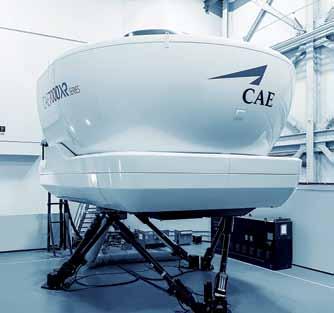
• CAE Tropos™ 6000XR for extreme visual realism
• Next-generation instructor office
• Upset Prevention Recovery Training
sive simulators include motion, and can mimic how an aircraft would react to things like turbulence, changes in wind direction and air density, visibility issues, and night operations. The top-of-the line simulators provide official training for aspiring pilots, all the way up to commercial.
Flight simulation continues to evolve, and with advances in virtual reality, some of these simulators are incredibly realistic. However, simulators require frequent updates, so going for a simulator that frequently releases new versions may be a better option.
Growing up in the digital age, raised on handheld computers, immersive video games and the Internet, younger pilots learn differently than the methods employed by many, traditional pilot training programmes. Therefore, to make that training more efficient, it is important to tailor training to individual students. SP
FlighTSAFeTy full flight simulators feature advanced instructional capabilities and are designed for maximum reliability, ease of maintenance and support. The new FlightSafety FS1000 full flight simulator’s new light weight and highly robust modular design offers added configuration flexibility and ease of systems integration. This enables the company to respond quickly as new aircraft and advances in technology are introduced and will serve to increase reliability and reduce maintenance time. This top-of-the-line training device uses highly evolved, sophisticated software drivers to replicate with the greatest possible fidelity all of the flight characteristics of the aircraft. FlightSafety simulators include a full range of flight conditions and malfunctions to ensure the best training outcome.

FRASCA’S Full Flight Simulators combine high fidelity with value. Their experience with Full Flight Simulators includes both fixed wing and rotary wing aircraft. Programmes include FFS deliveries for CJ1+, King Air, Cessna Caravan, Bell 412, Bell 407, S92, S76, and EC225 aircraft. The company builds Level B, C and D Full Flight Simulators with all the technology, sub-systems, bells and whistles required. Features like motion bases, visual systems, control loading, sound simulation and others are engineered with the highest attention to detail, realism, reliability and customer satisfaction.

TRU’S line of full flight simulators offer advanced, high-fidelity training at the lowest life cycle cost available. They achieve this through purpose-built technology, simplified maintenance requirements, low spare parts investment and remarkably low power consumption. here is what makes TRU simulators truly exceptional:

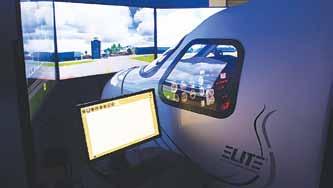
• high-fidelity professional simulation software based on original equipment manufacturer (OEM) and vendor data.
• Tailored solutions allowing you to choose between a fully incorporated aircraft panel and avionics, or a more extensively simulated equipment suite with a smaller footprint and reduced energy costs.
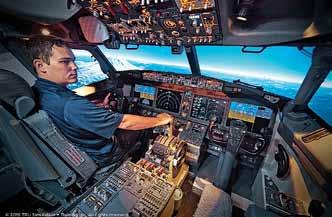
• Ability to support multiple aircraft configurations in one device.
• Simplified maintenance requirements.
• Reliability exceeding industry standards.
PReCiSion Flight Controls offers the most versatile reconfigurable FAA approved flight training devices in the industry. The DCX MAX is the newest Advanced Aviation Training Device (AATD) cockpit system on the market. The functionality rivals most flight training devices and full flight simulators. The system boasts an impressive list of standard and optional features that make it the most advanced trainer in its class. The DCX MAX represents the ultimate value for flight schools or universities that require maximum versatility, functionality and fidelity within a budget. The DCX MAX is deployed on six continents and is fast becoming one of the most popular cockpit AATD systems in the world.
An eliTe FAA-approved system the igATE series of Advanced Aviation Training Devices (AATD) — provides the owner tremendous savings on their flight training. The igATE ADVANTAgE features the latest digital technology and crystal clear LCD displays. These cutting-edge devices utilise precisely modelled flight dynamics with no Analog instruments to calibrate, wear out, or break. Train with accurate cockpit detail for maximum training transference from aircraft systems and avionics to navigation and flight procedures. Multiple aircraft models for training on simple, high performance or twin engine aircraft. On a single trainer, train on advanced avionics such as hSis, RMis, flight directors and gPS. Separate graphical instructor’s station with print and record capability, comprehensive failure modes & weather modelling. great for flight schools, FBos, college flight labs and corporate flight departments.
eCA gRoUP’S Exail Touch Screen Trainers feature type-specific cockpit replicas represented on touch screens with hardware integration of the most training-relevant 3D-replicated panels, placing trainees into an immersive, but not stressful, environment. Dedicated to flight – and also maintenance – crew training, the solutions offer the following training capabilities:
• Pre-flight procedures
• Surface operations (pre-take-off and post landing)
• Take-off and departure phase (normal, abnormal and emergency)
• in flight manoeuvres
• instrument Approaches and landing (normal, abnormal and emergency)
• Any flight phase – normal, abnormal and emergency procedures
Full-Flight Simulators from ASe provide high-fidelity training solutions with a cost-sensitive philosophy to help combine value and training efficiency. The ASE 2000 Series FFS are the business jet solution that provide for excellent flexibility in training of normal, abnormal, and emergency procedures as well as flight manoeuvres for initial training, recurrent training, and type rating certification. For instance, this series, up to Level D, is built to the highest quality and certification standards providing all equipment and software support necessary for ground and flight operations training.

In addition, this full motion package has all of the equipment and computer programmes necessary to represent the environment on the ground and in-flight. Moreover, this product line utilises an electric motion system for a cost-effective solution to a full motion experience.
ThAleS has announced the Level D qualification of the very first EC135 full-flight simulator (FFS) by the Civil Aviation Administration of China (CAAC). The Thales Reality h helicopter flight simulator is already in service around the world because it provides operational efficiencies and high quality mission-oriented training to pilots. This high-fidelity FFS features an extended visual display of 240 degrees x 80 degrees field of view, combined with high-resolution geospecific imagery from the ThalesView image generator and an efficient and user-friendly instructor operating system (IOS). Its unique and revolutionary all-electric motion system, hexaline provides the most realistic motion cues while requiring less power and very low maintenance. These innovative modelling technologies create a completely immersive environment that makes Reality h the most realistic and efficient training tool on the market to support helicopter operators’ key priorities of safety and mission success.
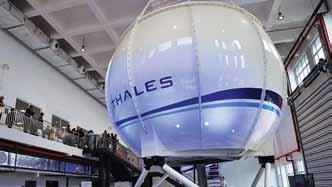
indRA´S Full Flight Simulators meet Level D EASA (formerly JAA), CAAC and FAA certification requirements and are renowned for their accuracy, detail and realistic flight performance on aircraft types like A320, B737-700/800, A330 and ATR72-500. indra Full Flight Simulators main features are:


• Full cockpit replica
• original Equipment Manufacturer (oEM) for sensitive parts
• Real, retarget, rehosted and simulated avionics
• Maximum fidelity flight models
• User-friendly instructor operation Station (ioS)
• Proprietary visual solution:
– indra inVis2 ig
– 200x40 field of view DS
– lCoS/lED
Wide range of airports
• 100 per cent electric Motion System
• Air traffic control (ATC) with speech recognition. SP
 By Ayushee ChAudhAry
By Ayushee ChAudhAry
Brazilian manufacturer Embraer has also been a leading player especially in the Latin American defence industry with its Defense & Security portfolio through its A-29 Super Tucano light attack and advanced trainer as well as the multi-mission C-390 Millennium military airlift. Apart from these, it provides a full line of integrated solutions and applications such as Command and Control Center (C4I), radars, ISR (Intelligence, Surveillance & Reconnaissance) and Space. This also includes integrated systems for information, communications, border monitoring and surveillance as well as aircraft for VIP transportation and special missions. With a
growing presence on the global market, Embraer Defense & Security products and solutions are present in more than 60 countries.
Embraer’s C-390 Millennium is a tactical transport jet aircraft designed to set new standards in its category. A joint project between FAB (Brazilian Air Force) and Embraer, the multimission jet aircraft features a rugged design that withstands operations from semi-prepared and damaged runways, as well as harsh environments. Mobility, robust design, greater flexibility, proven state-of-the-art technology, and easier maintenance are some of the strengths of this aircraft.
The C-390 Millennium flies faster and carries more cargo than other military freighters of the same size and are the ideal platforms for the main usage scenarios. The aircraft requires fewer on-demand inspections and maintenance, combined with highly reliable systems and components, which reduces the time on the ground and overall operating costs, contributing to excellent availability levels and low life-cycle costs. In 2019, Embraer announced the name and designation of its multi-mission medium aircraft, the Embraer C-390 Millennium. The new designation reflected increased flexibility and value for operators that look for a transport/cargo aircraft to perform airlift and air mobility missions, among others.
The C-390 is capable of transporting and launching cargo and troops and performing a wide array of missions: medical evacuation, search and rescue, humanitarian search and rescue, humanitarian aerial refuelling (fighters and helicopters), aerial fire-fighting and assistance. It has a modern cargo handling system which can transport large-sized cargo: pallets, vehicles, helicopters, troops, paratroopers, medevac stretchers, mixed configurations. The C-390’s piloting is facilitated by an integrated avionic system and a flyby- wire flight control, and it can be
equipped with a self-defence system and ballistic protection which increases its capacity to operate in hostile environments. The C-390 Millennium can be configured to carry up to 74 liters (STANAG 2040) and 8 additional members, including medical attendants and necessary life supporting equipment.
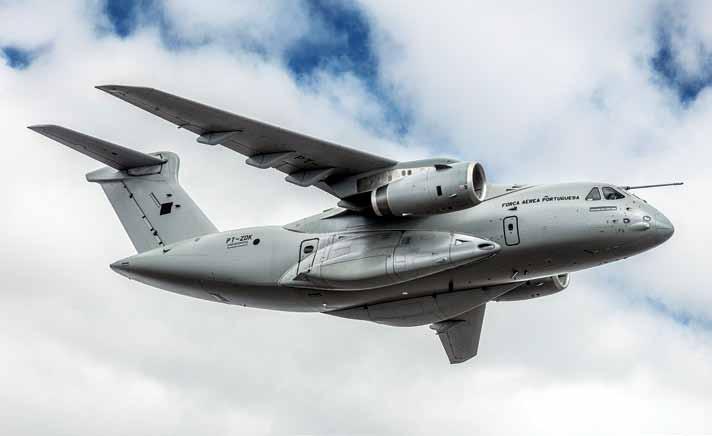
In April 2021, Embraer reached another important milestone in the development of the C-390 Millennium multi-mission military freighter programme with the successful conclusion of the aerial refuelling qualification between two C-390 Millennium, proving this new operational capacity of the aircraft. This allows C-390 Millennium operators to expand their logistical transport capacity and during search and rescue operations, which increases the autonomy and range of their missions.
This multi-mission aircraft can be quickly configured for aerial refuelling as both a tanker as well as a receiver aircraft. The refueling version of the C-390 has been titled as KC-390. Day and night aerial refuelling is made possible with observer windows and night vision cameras. The C-390 can be equipped with advanced refuelling pods that meet the high-performance criteria of the aircraft,
The C-390 is capable of transporting and launching cargo and troops and performing missions including medical evacuation, search and rescue, humanitarian, aerial fire-fighting and assistancePorTugal is The KC-390 PrograMMe’s greaTesT inTernaTional ParTner
providing a lightweight and efficient solution. Removable auxiliary fuel tanks can be installed in the cargo compartment to expand the aircraft fuel offload capacity or range performance. The C-390 Millennium can be reconfigured for all missions in three hours or less.
Flying faster and delivering more cargo, both the C-390 Millennium and the KC-390 variant are the right sized platform for major deployment scenarios. Minimised interventions and on-condition maintenance combined with highly reliable systems and components support the reduced downtime and costs, contributing to outstanding availability levels and low life cycle costs.
“The C-390 is certified to operate from an altitude of 14,000 ft which fits the operational requirements of the Indian Air Force (IAF) at high altitudes in India’s Northern sector. The KC-390 can easily provide aerial refueling to high speed fighters/jets due to its much flexible probe-and-drogue system. KC-390’s versatility due to its unique modern design, makes it best suited for the Indian Air Force which operates from different types of terrains. We have introduced the KC-390 to the Indian Air Force and whenever there is any such requirement from the IAF we will be happy to support them,” said Bosco da Costa Júnior, President & CEO, Embraer Defense & Security (EDS) in an exclusive interaction with SPs.
The advanced Cargo Handling System (CHS) provides high flexibility and productivity levels, merging a modern solution for software controlled cargo locking with proven cargo handling mechanical solutions. The CHS is designed to be easily and quickly reconfigured for different missions without the need for special tools. The cargo floor can be changed from flat to a roller configuration with the flip-over capability. The CHS features all the necessary accessories to facilitate cargo loading, restraining and offloading, such as tie-down rings, roller trays, cargo guidance and restraint systems.
“In Brazil, FAB used the KC-390 extensively in operations to transport medical equipment and supplies, from liquid oxygen to vehicles throughout Brazil at the height of the COVID19 outbreak. The KC-390 Millennium has demonstrated that it can support air forces quickly, responding to a variety of situations not only in military operations but also emergencies and humanitarian aid missions triggered by floods, forest fires, earthquakes, or situations like COVID,” added Da Costa.
The C-390 Millennium aerial delivery system provides remote and automatic release of cargo in flight at low and high altitudes. The C-390 Millennium is capable of:
• LVAD (Low Velocity Aerial Delivery) type-V platforms (single and multiple) up to 41,887 lb;
• Aerial delivery of CDS (Container Delivery System) up to 22 skid boards;
• Low Altitude Parachute Extraction (LAPES) up to 22,046 lb; • Also comes equipped with advanced Tactical Radar, featuring Spot SAR (Spotlight Synthetic Aperture Radar), weather, air-to-air, navigation, air-to-ground and high resolution modes.
The C-390 Millennium can be equipped with a complete self-protection suite (SPS) to increase survivability levels. Detection & Countermeasures with 360° coverage: Radar Warning Receiver (RWR), Laser Warning System (LWS), Missile Approach Warning System (MAWS), Chaff & Flare, Directional Infrared Counter Measures (DIRCM). It also has Electro Optics/Infrared Pod; Ballistic Protection (Armor 7.62 mm and 0.50 inch);
iae V2500-e5 engines with 31,330 lb of takeoff thrust
Collins Pro line fusion avionics system gabbiano Tactical radar T-20 from seleX galileo
Cobham 900e series Wing air refueling Pod
litening ii electro-optical/infrared targeting pod
Source: https://defense.embraer.com/global/en/c-390
features
Palletized aux. fuel Tanks up to 3 tanks, 8,800 lb / 4,000 kg each
Wing refueling Pods flow transfer up to 400 gPM
aerial refueling cameras day & night Cameras
refueling enveloPe
180 to 300 KCas up to 32,000 ft 120 to 140 KCas from 2,000 ft up to 10,000 ft
Enhanced Vision System The KC-390 is capable of refueling both fixed and rotary wing aircraft, operating at speeds from 120 KCAS to 300 KCAS and at altitudes from 2,000 ft to 32,000 ft. While the KC-390 Millennium on-ground refueling capability can be used to refuel vehicles or forward operating bases.(EVS); HALO Oxygen Rack.
Both fixed-wing and rotary-wing aircraft can be refuelled by the KC-390, which can fly at speeds between 120 and 300 KCAS at altitudes between 2,000 and 32,000 ft. Refueling of vehicles or forward operating bases is possible using the onground refuelling capability of the KC-390 Millennium.
In order to support national armed forces operations and improve readiness for missions of public interest, the Portuguese government placed a definite order for five multi-mission Embraer KC-390 airlifters in 2019.
The KC-390 ensures to set new standards for efficiency and productivity in its category while presenting the lowest life-cycle cost of the market. The aircraft can perform different types of military and civilian missions including humanitarian support, medical evacuation, search and rescue and firefighting, while fully meeting the requirements of the Portuguese Air Force, adding new superior cargo and troops transport, aerial delivery and aerial refueling capabilities. The KC-390 is currently
capable of receiving fuel, taking off and landing from short and makeshift runways, and refuelling aircraft in flight with a variable speed drogue. The KC-390 is currently flown by the Brazilian air force, and Portugal and Hungary are following suit.
In October 2022, Portuguese Air Force got its first KC-390 military transport aircraft from Embraer, a Brazilian aerospace company. The agreement also comprises the provision of a training simulator.
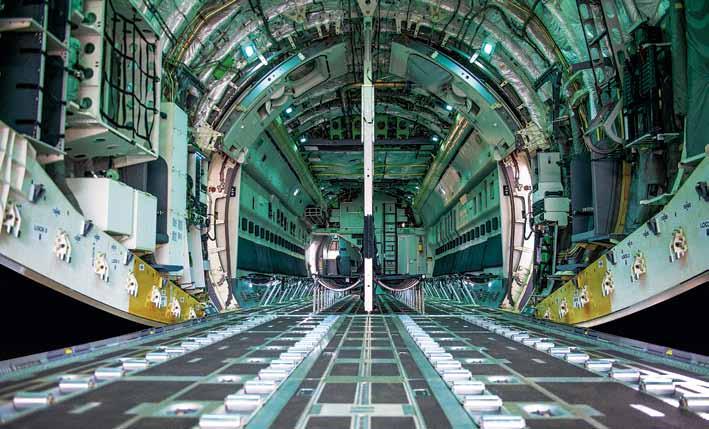
Embraer has disclosed a contract modification with the FAB to provide a total of 19 KC-390 twinjet transport planes to the service.
Portugal is the KC-390 programme’s greatest international partner, and it is acknowledged that its involvement in the development and construction of the aircraft helped Portugal’s economy by creating jobs, attracting new capital, growing exports, and advancing technology.
Additionally, Embraer has begun putting the semi-wings of the first of two KC-390 Millennium transport planes for the Hungarian Defense Forces on the fuselage. Embraer painted the wings in the hues of the Hungarian air force before the merger. The first KC-390 will make its first test flight in 2023 when assembly is finished, and it will then be handed over to the Hungarian Defense Forces by 2024. SP
Both fixed-wing and rotary-wing aircraft can be refuelled by the KC-390, which can fly at speeds between 120 and 300 KCAS at altitudes between 2,000 and 32,000 ftThis MulTi-Mission airCrafT Can be quiCKly Configured for aerial refuelling as boTh a TanKer as Well as a reCeiVer airCrafT The refueling Version of The C-390 has been TiTled as KC-390.
CFM International is on song. Since 1974, 50,000+ CFM56 and LEAP engines have been ordered. Till May 2022, more than 5,400 LEAP engines have been delivered and the company enjoys a 10,000+ order backlog for LEAP.
By Joseph NoroNhaThe stars must have been particularly favourable that day in 1974 when CFM International, the 50/50 joint venture between GE Aviation of the United States and Safran Aircraft Engines (formerly Snecma) of France came into being. Negotiations on the proposed partnership between the two gigantic transatlantic engine manufacturers had dragged on a while, mainly because the US was reluctant to share critical dual-use technology with a foreign entity. But finally all hurdles were cleared and the marriage covenant was sealed. Since then CFM International has never looked back.
Concentrating on just two turbofan engine families, both tailor-made to power the ubiquitous narrow-body twinjets, the company has cornered a commanding share of the market.
First off was the iconic CFM56. “CF” stands for GE’s designation for commercial turbofan engines, while “M56” is the name of Snecma’s original proposal. Over 35,500 CFM56 engines in several different commercial and military variants have been sold. No other engine comes close to this figure. Then, just as it began to seem that the CFM56’s dominance might be threatened by the Pratt & Whitney PW1000G – a new and more fuel-

efficient turbofan – CFM International came up with the LEAP (Leading Edge Aviation Propulsion) engine.
Since the first LEAP turbofan entered production in 2013, the programme has grown exponentially. More LEAP engines were built in the first five years of production ending 2018 than CFM56 engines in their first 25 years. In fact LEAP experienced the fastest order ramp up in commercial aviation history. Within a short span of time LEAP has become the second most ordered jet engine ever, lagging only its predecessor, the CFM56. The LEAP engine has already logged 20 million engine flight hours in commercial service. It has secured over 17,500 orders and commitments against around 10,000 orders and commitments that its chief rival, the Pratt & Whitney PW1000G, has secured.
It was on July 13, 2008, that CFM International formally launched its new multi-billion-dollar engine programme with the designation LEAP-X. Thereaf-

ter LEAP underwent the most comprehensive development and certification process in CFM history. LEAP reveals CFM International’s foresight because there didn’t seem to be any particular aircraft for which the engine might be needed at that point in time. The CFM56 was performing exceedingly well in the narrow-body airliner segment, dominated by the Airbus A320 and Boeing 737 families. However, the parent companies decided to proceed with the LEAP-X programme. And such was their confidence in their joint venture that they renewed their partnership agreement till 2040. They also launched CFM Services to support future CFM engines. This has emerged as a one-stop resource in which CFM’s service and support teams assist operators with solutions from heavy overhaul to on-site support and parts distribution.
The LEAP family includes three different models with a thrust range from 23,000 to 35,000 pounds. LEAP engines currently equip, among others, the Air-
In July 2022, Gaël Méheust, President and CEO of CFM International said that the LEAP family had achieved a dispatch reliability rate higher than 99.95 per cent
bus A320neo (LEAP-1A), the Boeing 737 MAX (LEAP-1B) and the Comac C919 (LEAP-1C). LEAP is an environmentally-friendly turbofan that delivers 15 per cent lower fuel consumption and CO2 emissions. Half of the fuel burn savings comes from the high-pressure compressor, the other half from the fan. Nitrogen Oxide (NOx) emissions are also 50 per cent lower and the engine meets the most stringent current noise standards of the International Civil Aviation Organization (ICAO).
The LEAP engine is a twin-spool, high bypass turbofan with a 3-stage low pressure (LP) and 10-stage high pressure (HP) compressor. It has a second generation twin-annular, pre-mixing swirler combustor (TAPS II) and a 2-stage HP turbine and 7-stage LP turbine (LEAP-1B has five stages). Its overall pressure ratio (OPR) is 40:1.
Here are some significant milestones in LEAP’s journey:
• July 13, 2008: CFM launches the advanced LEAP-X engine.
• September 4, 2013: The first full LEAP-1A begins ground testing.
• October 6, 2014: The first LEAP fitted on GE Aviation’s modified Boeing 747 flying test bed begins flight testing.
• August 2, 2016: Pegasus Airlines becomes the first carrier to introduce the LEAP-1A-powered Airbus A320neo into commercial service.
• May 23, 2017: Malindo becomes the first carrier to introduce the LEAP-1B-powered Boeing 737 MAX 8 into commercial service.
• Spring 2023: China Eastern Airlines is scheduled to introduce the LEAP-1C-powered Comac C919 into commercial service.
Making a new jet engine ranks somewhere near the summit of current human technological endeavour. And when the LEAP programme commenced in 2008, CFM International had not designed a new turbofan for 34 years. But it had the invaluable operational experience of nearly one billion engine flight hours logged on the CFM56 turbofan family. Using this knowledge base, and resisting the temptation to simply tweak the CFM56 design, it was able to develop and build a revolutionary new engine.
LEAP features advanced aerodynamics, environmental and materials technology. The design incorporates the first-ever 3D woven carbon fibre composite (CFC) fan blades and fan case,
ceramic matrix composites (CMC) in the hot section, and the first use of 3D-printed parts for critical engine components. Here are some innovative aspects of LEAP’s technology:
• 3D woven CFC materials and the RTM (resin transfer moulding) process developed by Safran are used to produce the single-piece fan blades and fan case. These are incredibly strong, light and durable. The technique was selected because of the significant weight reduction of about 500 kg per aircraft relative to metal components.
• The HP hot section compressor delivers an impressive 22:1 compression ratio, twice that of the CFM56 family.
• The LP turbine blades are machined from an advanced titanium-aluminide alloy that is lighter and more resistant to high temperatures than previous blades.
• The LP turbine rings are made of CMC. CMC is an advanced lightweight and heat-resistant material containing silicon carbide fibres. Each LEAP engine has 18 CMC turbine shrouds.
• The fuel injectors and more than 35 other complex components are made, layer by layer, using computer-aided design (CAD) and additive manufacturing techniques (3D printing). Hence, the number of parts in a fuel nozzle tip, that used to be about 20 pieces welded together, is reduced to just one seamless piece. This reduces the nozzle tip’s weight by about 25 per cent.
• The TAPS II twin-annular, premixing swirler is like a nozzle on a dual mission: to lower maintenance costs and cut greenhouse gas emissions at the same time.
• The engine’s thermal efficiency is greatly enhanced. Although the LEAP engine burns hotter than the CFM56, the CFM56 family’s durability is maintained, thanks to improved cooling technology and aerodynamics.
• In yet another innovation, CFM has fitted LEAP with a debris rejection system. The aim is to keep sand, salt, gravel, airborne effluents, and the like from entering the engine’s core where they can wreak havoc with parts and increase fuel burn. The system promotes fuel economy and results in a far more durable engine.
from LEAP to risE
CFM International reportedly evaluated 18 different architectures for the LEAP engine, including the geared turbofan (GTF) design that Pratt and Whitney opted for. It is perhaps conscious of the fact that the GTF being a new architec-
Within a short span of time LEAP has become the second most ordered jet engine ever, lagging only its predecessor, the CFM56Source: MTU Maintenance Zhuhai and Wikipedia
ture may have more scope for upgradation than LEAP, which is of a more conventional design. Hence, although LEAP has leapfrogged the competition in its first decade of production, and will probably remain the market leader for the foreseeable future, the company is already considering after LEAP.
On June 14, 2021, CFM International launched the RISE (Revolutionary Innovation for Sustainable Engines) Technology Demonstration Program that aims to produce a new generation gasturbine engine design by around 2035. It will have an open rotor or fan and will be without the conventional pod around the fan blades. The blades will be of woven carbon composites, and perhaps as large as 156 inches in diameter, thus sweeping backward a far greater volume of air than present engines. From the start it will have a strong green focus, aiming to reduce fuel consumption by at least 20 per cent. It will be compatible with 100 per cent sustainable aviation fuel (SAF). It will be capable of hybrid-electric operation, in which part of the thrust is provided by electrical power, and also permit running on hydrogen.

In July 2022, Gaël Méheust, President and CEO of CFM International said that the LEAP family had achieved a dispatch reliability rate higher than 99.95 per cent. He stated that this figure was even better than that attained by the CFM56 during its nearly 40 years in service. While it took the CFM56 25 years to reach the extremely high dispatch reliability for which the family is deservedly known, the LEAP family has equalled it within just six years. The LEAP-1A and LEAP-1B have also secured 180-minute
ETOPS (Extended-range Twin-engine Operations Performance Standards) certification.
The LEAP-1C has been dormant due to delays in Comac C919 development. However, in December 2022, the first C919 was delivered to launch customer China Eastern Airlines. It is expected to make its first commercial flight this spring. CFM International has also commenced work on a version of the LEAP-1A that will generate 34,000 pounds (151 kN) of maximum take-off thrust for the forthcoming Airbus A321XLR. Designated the LEAP-1A35A, this highest-thrust version of the LEAP so far will physically replicate other LEAP-1A engines.
CFM International is on song. Since 1974, 50,000+ CFM56 and LEAP engines have been ordered. Till May 2022, more than 5,400 LEAP engines have been delivered and the company enjoys a 10,000+ order backlog for LEAP. This year, in response to the heavy demand for LEAP, CFM plans to ship a total of 2,000 engines, up from just 845 in 2021, when the COVID-19 pandemic cast a spanner in the works, and around 1,600 in 2022, which was a year of recovery. This increase has been achieved despite severe disruption of supply chains and labour due to the COVID-19 pandemic and the war in Ukraine. From 2024 onwards, LEAP production is planned to exceed 2,000 engines every year and CFM International expects the LEAP turbofan to reach breakeven margins in 2025. CFM56 commercial production earlier wound down in 2020, and even limited production for military aircraft, as well as production of CFM56 spares, is due to end in 2024. Thereafter it will be LEAP all the way. SP
Till May 2022, more than 5,400 LEAP engines have been delivered and the company enjoys a 10,000+ order backlog for LEAP
The 74th Republic Day parade concluded with a spectacular flypast by the Indian Air Force despite the inclement weather
this January 26, 2023, india celebrated its 74th republic Day led by President Droupadi Murmu. The military might of the nation in all its vigour and vibrant colours of the nation could be seen in all their glory on the Kartavya Path in New Delhi. The most-awaited grand-finale through the Fly Past, although hindered by the foggy weather, took place showing the utmost professionalism of the Indian Air Force. The Fly Past consisted of an air show by 45 aircraft of the Indian
Air Force, one from the Indian Navy and four helicopters of the Indian Army. Vintage as well as current modern aircraft/ helicopters like Rafale, MiG-29, Su-30 MkI, Jaguar, C-130, C-17, Dornier, Dakota, LCH Prachand, Apache, Sarang & AEW&C flew in different formations, including Baaz, Prachand, Tiranga, Tangail, Vajrang, Garud, Bheem, Amrit and Trishul along with a vertical charlie manouevre by Rafale fighter aircraft. SP

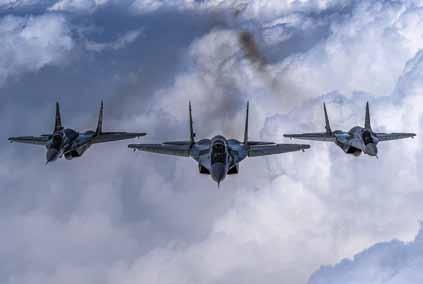
(toP LeFt) LIght Combat heLICoPter (PraChand) In the Lead, FLanked by two aPaChes, wIth two aLh mkIV (rudra) on the outsIde oF the FormatIon CrossIng the sahIbI rIVer between najaFgarh and dwarka; (toP rIght) baaz FormatIon ComPrIsIng oF 3 mIg-29 uPg muLtIroLe FIghter oF the IaF; (aboVe rIght) mI-17 IV CarryIng FLags oF the Country and the 3 arms oF our armed ForCes.
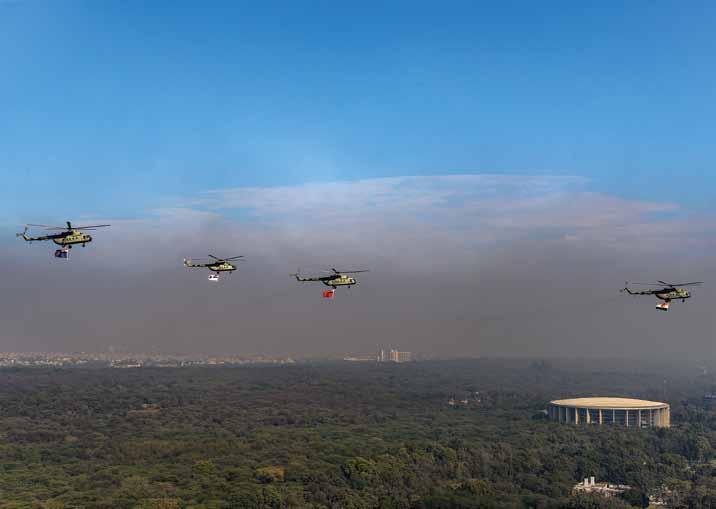
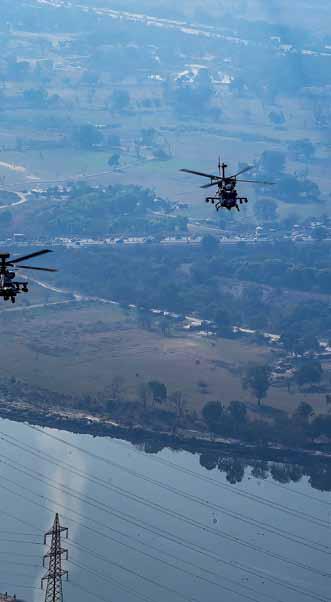
(toP) netra FormatIon ComPrIsIng oF aew&C netra In the Center FLanked by Four raFaLe muLtI roLe FIghters on january 26, 2023;
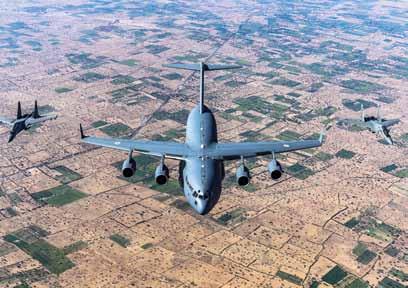
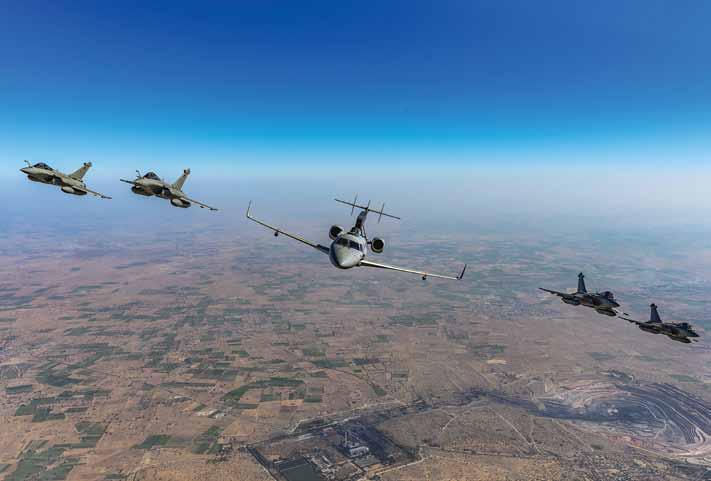
(aboVe LeFt) bheem FormatIon ComPrIsIng a C-17 heaVy LIFt transPort aIrCraFt FLanked by two su-30 mkI aIr suPerIorIty FIghters;
(aboVe rIght) Vajraang FormatIon ComPrIsIng a C-130 suPer herCuLes transPort aIrCraFt In the Center FLanked by two raFaLe muLtIroLe FIghters on eIther sIde.

Pakistan had in mind a fighter jet that would be at par with the Su-30 MKI, MiG-29, and Mirage 2000. However, because the JF-17 is a low-cost fighter built with sub-standard Chinese avionics and armaments, the aircraft is significantly below its anticipated capabilities.
By Group Captain D.K. panDey (retD)China and Pakistan’s “Joint Fighter-17” (JF-17) is a single-engine, multi-role fighter of Pakistan Air Force (PAF), with the ability to conduct aerial reconnaissance, ground attack, and interception missions. Both, China and Pakistan, are desperately looking for buyers of JF-17s. The publicly announced rejection of the JF-17 by Malaysia and Sri Lanka appears to have been a setback for the modernisation programme of PAF. Several times, the Pakistani and other media reported that a number of air forces were considering the purchase of the JF-17. Later such claims were proven false. They also listed more than a dozen potential export markets for the JF-17, including Argentina, Bangladesh, Bulgaria, Myanmar, Nigeria, the Philippines, Venezuela, and Zimbabwe. The export possibilities for the JF-17 have been the subject of countless rumours and false beginnings.

JF-17 was the dream project for Pakistan. It multiplied the PAF’s dreams, but the development of the project, since inception, was ‘dim’, and the dividends only existed as dreams. In June 1999, China and Pakistan signed a contract to develop and produce the Chengdu ‘FC-1 / Super-7’ in Pakistan. The Chinese designation “FC-1” stands for “Fighter China-1”. They had agreed to split the project cost. In addition, there are striking similarities between it and the US company Lockheed Martin’s F-16. Both nations’ air forces agreed to place sizable orders for the aircraft as part of the 50:50 partnership agreement. PAF has a minimum need of 200 of these platforms. The plane’s name was changed to “Joint Fighter-17” in 2003, with the “-17” denoting that, in the PAF’s vision, it is the successor to the F-16. The hype surrounding it as the best fighter aircraft in the world was completely baseless.
The ‘first’ prototype went into production in September 2002, and a full-size mock-up was on show at the Air Show China in November 2002. The fighter was introduced to replace the PAF fleet’s outdated A-5C, F-7P, Mirage 3 and Mirage 5 aircraft, all of which were originally planned for replacement.
The Aircraft Manufacturing Factory (AMF) final assembly line at Pakistan Aeronautical Complex (PAC) Kamra has already started producing the multirole fighter aircraft JF-17 “Thunder” Block III. According to Air Chief Marshal Mujahid Anwar Khan, the PAF Chief of Air Staff, another 50 x JF-17 Block IIIs are anticipated to be inducted by 2024.
According to information published in March 2022 by “Sweden’s Stockholm International Peace Research Institute” (SIPRI), Beijing satisfied 72 per cent of Islamabad’s demand for major arms between 2017 and 2021. In contrast, according to SIPRI, 47 per cent of China’s total major arms exports during that period went to Pakistan. Several of the agreements are marked “co-production” or “joint programme,” suggesting significant contribution of Pakistani Research and Development (R&D). This, however, is factually false, as SIPRI’s analysis demonstrates that, in the vast majority of cases, the R&D is either entirely or primarily Chinese. Chinese teams have even created the modules specifically demanded by Pakistan.
According to a New York Times (NYT) report, the PAF has “an alternative to the US-built F-16 fighters thanks to the JF-17”. As per the reports, “Pakistan assembles the Chinese aircraft at the Kamra Aeronautical Complex in the Punjab region. China-Pakistan Economic Cooperation” (CPEC), which is a component of the Belt and Road Initiative (BRI), is linked to Pakistan’s alliance with the Chinese Air Force. Pakistan is working with China on distinctly defence-related projects as part of the BRI, including a covert plan to develop new fighter jets, which China claims to be a peaceful project.” The NYT report was immediately refuted by the Pakistan Foreign Office who claimed that CPEC was purely an economic endeavour with no military component.
According to a report in the UK’s Financial Times newspaper, the West is irritated by the growing defence cooperation between China and Pakistan. The joint JF-17 Thunder fighter jet, the Burraq armed drone, and the specially designed AIPequipped submarines are all mentioned in the paper as examples of the close cooperation between the two countries.
Though Pakistan asserts that the PAC, at Kamra, has the maximum Share (58 per cent) of the production, this is untrue. The JF-17 is put together at a sub-assembly line of Kamra’s Aircraft Manufacturing Factory using raw materials and production kits imported from CAIC, China. Only a few sub-assemblies, including the wings, front fuselage, and tail, are produced by PAC using materials that are once again imported from China. The ejection seat is from Martin Baker; however, the majority of the systems are Chinese, South African, and European (UK).
JF-17 was intended to be a low-priced, lightweight, all-weather multi-role fighter with a Chinese airframe, outfitted with Western avionics, and powered by the Russian Klimov RD- 93 Aero Engine.
Pakistan had in mind a fighter jet that would be at par with the Su-30 MKI, MiG-29, and Mirage 2000. The aircraft’s better capabilities were even mentioned as a reason why China would introduce it. According to a statement from the Aviation Industry Corporation of China (AVIC), “JF-17s were built to meet the requirements of international customers and the global market. “However, because it is a low-cost fighter built with sub-standard Chinese avionics and armaments, the aircraft is significantly below its anticipated capabilities. According to reports, in its western border regions, Pakistan has used jets made in China to kill terrorists. These fighters were JF-17B, an updated version of the JF-17.
According to SIPRI, reports, JF-17 are planned to be equipped with the Ra’ad Air-Launched Cruise Missile (ALCM). This will provide this PAF’s fighter-bombers with a standoff nuclear capability. It has been flight-tested seven times since 2007. The last reported flight test was in 2016.
The Ra’ad-II, an improved model that made its debut in 2017 and is presumed to have a 600-kilometer range, is an improved version. Ra’ad II is nuclear-capable ALCM variant and also known as the Hatf VIII.
The PAF’s JF-17, claimed to be frontline fighter, has maintenance problems that are getting worse every day. The reason is the RD-93, the engine of JF-17. The RD-93 is Russian made engine. Aircraft engines need to be regularly overhauled as part of the scheduled maintenance plans defined by the Original Equipment Manufacturer (OEM). After a certain number of flight hours, these engines are mandatorily required to be replaced. These maintenance activities are highly affected as original equipment supplier ‘Rosoboronexport’ is under strict economic sanctions by the United States of America and other NATO Countries, due to Russia-Ukraine war. Rosoboronexport is the only state-controlled intermediary in Russia for exports and imports of the full spectrum of military and dual-purpose goods, services, and technologies, since 2018.
Rosoboronexport is unable to conduct transactions in US dollars due to the sanctions. Thus, according to sources, there are payment issues that the two governments and the concerned banks have yet to resolve. As a result, getting the JF-17 ready for flight is getting more challenging and will get more complex.
The PAF and the “China National Aero-Technology Import and Export Corporation” (CATIC), are attempting to substitute a Chinese RD-93 engine for the Russian one as a workaround. However, it remains to be seen ‘how capable this retro-fitment will be’ and ‘how long it will take to get materialised’.
issues WitH paf Jf-17
Over 100 JF-17 Block 1 & 2 fighters are currently in service with the PAF. There are about 40 un-airworthy aircraft. Guide vanes, exhaust nozzles, and flame stabilisers have reportedly developed cracks in a significant number of engines. It’s challenging to replace the substandard engines.
PAF’s JF-17 has maintenance problems that are getting worse every day. The reason is the RD-93, the engine of JF-17s. The RD93 is Russian made engine.
JF-17 in the Air Defence role was reported to be unreliable. It has an indigenous Link-17 data link. Reports say “it does not have sufficient data transfer rate. The aircraft’s true interoperability capability is limited as it can never be integrated with the F-16 fighter’s Link-16”. The ‘Thunder’ does not have even an effective BVR or Airborne Interception radar. It was hailed as the second-best PAF fighter after the F-16, but “on February 27, 2019, in the face of effective jamming and strikes by Indian pilots, all of its Range Extension Kit (REK) bombs missed their intended target.
JF-17 avionics are supported by the KLJ-7 radar, but it consistently performs much below stipulated levels and has experienced numerous operational problems since the project’s inception.
The competence of a fighter aircraft is assessed on the basis of the effectivity avionics, weapons, and engine configuration. JF-17 is assessed to be much inferior to the stipulated standards. The major unremarkable flaws of JF-17 are:
• Low Endurance;
• Poor Accuracy;
• Unreliable Airborne Interception Radar;
• Low Weapon Carrying Capability;
• Maintenance problems;
• Low credibility of Aircraft Main Computer, and
• Frequent failures of a number of its modules.
It was termed as “PAF JF-17 Blunder” after the crash of JF-17 during a training mission on September 15, 2020.
Numerous JF-17 aircraft failures were reported, which were largely attributable to the RD-93 engines’ serviceability. Worried Pakistan bypassed China and went straight to Russia to purchase the RD-93 engines. Series of negotiations between
Islamabad and Moscow paid the dividends. Now Kilmov, the Russian engine manufacturer has expressed its willingness to provide RD-93 engines. The deal includes relevant accompanying repair systems and maintenance facilities to JF-17 aircraft.
With a minimum reliance on imports from other nations, the JF-17 was made to satisfy the tactical and strategic needs of the Pakistani Air Force. After the US restricted sales of F-16 warplanes following the 1990 Pressler amendment-imposed arms embargo on Pakistan, the JF-17 has become a mainstay of the PAF. Claimed to be a low-cost, indigenous, all-weather multi-role fighter of Pakistan, JF-17 ’Thunder’, turned out to be a failure. With the high cost of operations and maintenance compared to more modern weapon systems, the JF-17 Thunder has now turned into a liability for Islamabad. The JF-17 recorded a string of crashes and frequent technical breakdowns, casting serious doubts on the fitness of the aircraft. The JF-17 struggled against IAF Mirage 2000 and Su-30s on February 27, 2019, in an effort to retaliate to the Indian Air Force targeting a Pakistani terrorist group.
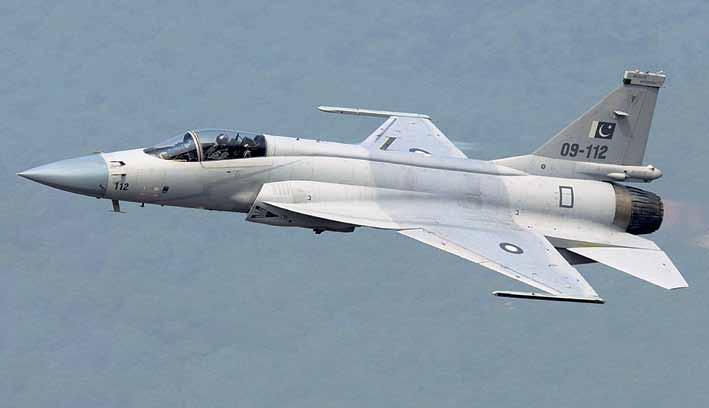
About 15 x JF-17s from the PAF are located in Masroor, Karachi (this is its second squadron); about 50 are in Minhas, Kamra (14th and 16th squadron); about 15 are in Samungli, close to Quetta; and about 20 are in Peshawar. These JF-17s will eventually require new engines for replacements, overhauled engines, or other associated spare parts in due course. More than 50 per cent of the 137 x JF-17s that the PAF owned were grounded as a result of the numerous snags of the aircraft.
PAF has to initiate necessary measures for long term planning of preventive as well as scheduled maintenance of its aircraft fleets for the sustenance of required op-preparedness. SP

The Bell X-1 was a marvel of aeronautical engineering. The fuselage was shaped like a 0.50 calibre Browning machine gun bullet, which was known to be stable at supersonic speeds.
The Bell X-1 was the first aircraft to break the “sound barrier” or fly faster than the speed of sound. This rocketpowered plane built by Bell Aircraft of the United States first flew on January 19, 1946, and changed aviation history in numerous ways. It established the concept of pure research aircraft – those built solely for experimental purposes and unconstrained by military or commercial requirements. In October 1947, Captain Charles “Chuck” Yeager flying the X-1 reached a speed of Mach 1.06 thus becoming the first person to fly supersonic. Yeager’s flight was possibly the most important since Orville Wright piloting the Wright Flyer made the world’s first controlled, sustained flight of a powered, heavierthan-air aircraft in 1903. Realising the military significance of Yeager’s achievement, the US Air Force (USAF) designated his flight and its data as Top Secret. It was officially confirmed only in March 1948. In 1950, USAF Chief of Staff Hoyt Vandenberg said the flight had “marked the end of the first great period of the air age, and the beginning of the second. In a few moments, the subsonic period became history, and the supersonic period was born.”
The Bell X-1 was a marvel of aeronautical engineering. The fuselage was shaped like a 0.50 calibre Browning machine gun bullet, which was known to be stable at supersonic speeds. The wings were straight and relatively thin. Scores of Bell engineers and mechanics, ground crew and pilots, toiled for months to challenge the limits of high-speed and high-altitude flight. In its final form, the X-1 had a fuselage chock-a-block with two liquid propellant tanks, twelve nitrogen spheres for fuel and cabin pressurisation, the pilot’s pressurised cockpit, three pressure regulators, a retractable landing gear, the wing carry-through structure, and more than 225 kg of special flight-test instrumentation. It was powered by a single Reaction Motors RMI LR-8-RM-5 rocket, rated at 6,000 lbf (27 kN), which could run just four minutes and 45 seconds.
The Bell X-1 was originally designed to take off from a runway. But since its sole purpose was to cross Mach 1, it was decided to lift it to high altitude using another plane before releasing it. And a heavily modified B-29 Superfortress was the only aircraft then capable of carrying a fully fuelled X-1. A retractable ladder allowed the pilot to descend from the B-29 and enter the tiny starboard hatch of the X-1. It would be air-
launched from the B-29 at an altitude of 23,000 to 25,000 feet, and then fire its rocket engine to climb to its test altitude.
The X-1’s first glide flight was on January 19, 1946, by Bell test pilot Jack Woolams. Woolams made 10 glide flights to test the plane’s handling characteristics before installation of the rocket engine. In early 1946, the Bell X-1 project was moved to Muroc Army Air Field in California’s Mojave Desert. The site had a crucial advantage – the nearby Rogers Dry Lake offered 170 square kilometres of flat natural runways and plenty of space for emergency landings. Bell test pilot Chalmers Goodlin made the first glide flight in the powered X-1 on October 11, 1946. After a total of four glide flights, he made the first powered flight on December 9, reaching a speed of Mach 0.79.
Chuck Yeager was chosen as the pilot to attempt to breach the sound barrier. After a few glide flights in early August 1947, he made his first powered flight in the X-1 on August 29, reaching Mach 0.85. But during a test flight in early October, Chuck Yeager completely lost elevator effectiveness at 0.92 Mach due to compressibility effects. It was a serious setback. However, a brilliant engineer named Dick Frost proposed a simple modification – a vertical worm gear that would permit the pilot to operate the horizontal stabilizer in flight. On the next flight, as Yeager approached 0.92 Mach, the shock waves again hit the elevator, depriving him of pitch control. All he had to do was set the stabilizer to two degrees down to regain control. And at 0.94 Mach the buffeting stopped.
On October 14, 1947, Yeager broke the sound barrier while flying a Bell X-1 named “Glamorous Glennis” in honour of his wife. He reached a speed of Mach 1.06 (807 mph, 1,299 km/h) at 43,000 feet. The X-1 continued flight testing until mid-1950, by which time it had completed a total of 78 flights – 19 contractor demonstration flights and 59 USAF test flights. On March 26, 1948, with Yeager at the controls, another X-1 variant attained a speed of Mach 1.45 (957 mph, 1,540 km/h), at an altitude of 71,900 feet. This was the highest speed and altitude reached by a crewed aircraft till then. In November 1958, the Bell X-1 programme was brought to a close after thirteen years of record-setting flights. SP
— Joseph NoroNhaDefence Minister Rajnath Singh reviewed the preparations of the forthcoming Aero India during the apex committee meeting held in New Delhi on January 24, 2023. The Defence Minister was given a detailed account of the arrangements of the 14th edition of Asia’s largest aero show, which will be held in Bengaluru, Karnataka between February 13-17, 2023. Rajnath Singh exhorted all the stakeholders to ensure fool-proof arrangements for the participants. He said, Aero India 2023 will not just be an event, but a display of the growing prowess of the defence& aerospace sector and the rise of a strong & self-reliant ‘New India’.

The five-day event, on the theme ‘The runway to a billion opportunities’, will be the largest-ever aero show organised at Air Force Station, Yelahanka in a total area of around 35,000 sqm. As on date, 731 exhibitors have registered for the event. Defence Ministers’ Conclave, with the theme ‘Shared Prosperity Through Enhanced Engagement in Defence (SPEED)’, and a CEOs Roundtable are among the marquee events. The Manthan start-up event and Bandhan ceremony, which witnesses signing of MoUs, will also be part of the event, along with a fabulous air show on all the five days. It will showcase the paradigm shift the Government has brought in the aim of organising such events, that also include DefExpo. The events have been restructured with focus on increasing defence exports and forging partnerships rather than merely import of weapons/equipment.

Air M A rsh A l PA nk A j Moh A n s inh A Assu M es Co MMA nd of i A f ’s Western Air Co MMA nd
Air Marshal Pankaj Mohan Sinha assumed command of the Indian Air Force’s Western Air Command on January 1, 2023.The Air Marshal is a graduate of National Defence Academy, Pune and was commissioned into the IAF as a fighter pilot in June 1985. He is an alumnus of the prestigious Defence Services Staff College, Wellington. An experienced fighter pilot, Category ‘A’ Qualified Flying Instructor, Fighter Striker Leader, Instrument Rating Instructor & Examiner, Air Marshal Sinha has more than 4,500 hours of flying experience.
Boeing
es n e W President of Boeing i ntern Ation A
Boeing announced that Dr. Brendan Nelson will take over as President of Boeing International (BI) and lead the company’s international strategy and corporate operations. The former Australian diplomat and government minister will succeed Sir Michael Arthur. Nelson will report to Boeing President and CEO Dave Calhoun and join the company’s executive council.
Citadel Completions announced the appointment of Neil J. Boyle as its Sr. Vice President of Operations and General Manager, effective March 1, 2023. In his new position, Neil Boyle will be accountable for the successful execution and delivery of V/VIP Completions projects while providing leadership and direction for all aspects of Completions and MRO programmes, reporting directly to the family ownership group.
The Aeronautics Group has appointed Dan Slasky as the CEO of the company, which is a leading provider of integrated turnkey solutions based on unmanned systems platforms, payloads and communications for defence and HLS applications. Dan will enter into his role as CEO of the Aeronautics Group within the next few months.
Air expo India, a brand new general and business aviation exhibition, will be hosted by Delhi International Airport (a GMR Airports Limited company) on November 22-24, 2023 at Indira Gandhi International Airport. The show was officially launched in New Delhi on December 14 when DIAL and Adone Events signed a protocol agreement to organise the show. A first for New Delhi, the event connects general and business aviation to the region, home to the fastest-growing aviation market in the world.
The show launch highlights the growth potential of the country’s aviation market and will take place over a threeday period. It will welcome exhibitors and delegates from Asia and the Middle East, representing local and international aero-
space companies, owners, operators, suppliers, and media. An industry first, the show will house one of the biggest static displays of eVTOL and electric aircraft in support of India’s intent to become a manufacturing center for these aircraft.
Air Expo India is targeting a mix of general and business aviation exhibitors who will come together on a static area totaling 60,000 sqm. The space will accommodate more than 100 aircraft ranging in size from single and twin-engine models to turboprops and private jets. The show format will reflect the approach taken at Abu Dhabi Air Expo, France Air Expo and African Air Expo, also organised by Adone Events, which offers exhibits located next to the runway enabling manufacturers to present their whole range of aircraft. SP
the Indian Air Force (IAF) and Japan Air Self Defence Force (JASDF) concluded in Japan, on January 26, 2023. The JASDF participated in the exercise with its F-2 and F-15 aircraft, while the IAF contingent participated with the Su-30 MKI aircraft. The IAF fighter contingent was complemented by one IL-78 Flight Refueling Aircraft and two C-17 Globemaster strategic airlift transport aircraft.
During the joint training spanning 16 days, the two Air Forces engaged in complex and comprehensive aerial manoeuvres in multiple simulated operational scenarios. The exercise involved precise planning and skillful execution by both the air forces. IAF and JASDF engaged in air combat manoeuvring, interception and air defence missions, both in Visual and Beyond Visual Range settings. Aircrew of the two participating Air Forces also flew in each other’s fighter aircraft to gain a deeper understanding of each other’s operating philosophies.
Exercise ‘Veer Guardian 2023’ provided the two Air Forces with an opportunity to enhance mutual understanding.
first fuselage for inDian arMy ah-64 apache

More than 90 percent of the parts used in these aerostructures assemblies are manufactured within India through over 100 Micro, Small and Medium Enterprises (MSME) suppliers in support of the government’s vision for Make in India. Tata Group recently won the “Supplier of the year” award 2022 from Boeing, from among more than 11,000 suppliers worldwide.
dling. This F-16 Block 70 jet is the first of 16 jets to be delivered to Bahrain.
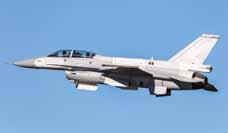
Tata Boeing Aerospace Limited (TBAL) has delivered the first fuselage for six AH-64 Apache attack helicopters ordered by the Indian Army from its stateof-the-art facility in Hyderabad. Boeing had completed the deliveries of all 22 AH-64E Apache helicopters to the Indian Air Force in 2020.
TBAL’s 14,000 sq. m. facility in addition to being a global sole source supplier for Apache fuselages, produces complex aero-structures for Boeing 737 and 777 models. The joint venture between Boeing and Tata Advanced systems Limited (TASL) employs over 900 engineers and technicians and utilises cutting-edge robotics, automation and advanced aerospace concepts in its manufacturing processes.
TBAL has produced and supplied Boeing’s Apache final assembly plant in Mesa, Arizona with over 190 fuselages.
L3Harris Technologies and Aerojet Rocketdyne Holdings together announced the signing of a definitive agreement for L3Harris to acquire Aerojet Rocketdyne. This marks L3Harris’ second acquisition announcement of 2022, demonstrating its continued focus on delivering critical capabilities to warfighters while strengthening the nation’s defence industrial base through increased competition.
A proven provider of world-class propulsion systems and energetics to the DoD, NASA and other partners and allies worldwide, Aerojet Rocketdyne has a 100-year heritage of excellence delivering some of the most significant moments in space exploration and discovery, while leading the industry with investments in rocket propulsion that support America’s warfighters and enhance integrated deterrence.
The acquisition will ensure the defence industrial base and our customers will have a strengthened merchant supplier to effectively address both current and emerging threats – and promote scientific discovery and innovation –through targeted investment in advanced missile technologies, hypersonics and more.

Lockheed Martin announced the successful first flight of the F-16 Block 70 at its South Carolina site. The flight occurred January 24 and total flight time was approximately 50 minutes and included airworthiness checks, such as engine, flight control and fuel system checks, as well as basic aircraft han-
Six countries have selected Block 70/72 aircraft. In addition to the current official backlog of 128 jets to-date to be built in Greenville, Jordan last year signed a Letter of Offer and Acceptance (LOA) for eight jets and last week signed an additional LOA for four more jets. Lockheed Martin has received a contract to begin Jordan’s long-lead activities. Bulgaria has also signed an LOA for an additional eight jets for its fleet. Once these are finalized, the backlog will increase to 148.
Boeing selecteD for nasa sustainaBle flight DeMonstrator awarD
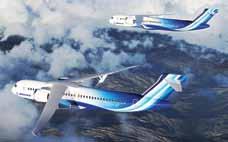
NASA has selected Boeing and its industry team to lead the development and flight testing of a full-scale Transonic Truss-Braced Wing (TTBW) demonstrator airplane.The technologies demonstrated and tested as part of the Sustainable Flight Demonstrator (SFD) programme will inform future designs and could lead to breakthrough aerodynamics and fuel efficiency gains.
When combined with expected advancements in propulsion systems, materials and systems architecture, a single-aisle airplane with a TTBW configuration could reduce fuel consumption and emissions up to 30 per cent relative to today’s most efficient single-aisle airplanes, depending on the mission. The SFD programme aims to advance the civil aviation industry’s commitment to reaching net zero carbon emissions by 2050, as well as the goals set forth in the White House’s US Aviation Climate Action Plan. l


pratt & whitney, a raytheon technologies business, officially opened the doors to its new India Engineering Centre (IEC) in Bengaluru. The facility is co-located with Pratt & Whitney’s India Capabilities Centre (ICC), which opened in 2022 to provide integrated global supply chain support, and the recently inaugurated Collins Aerospace engineering and global operations centres. The IEC, which was designed to meet the LEED Platinum certification, further enhances Raytheon Technologies’ combined presence in India of over 5,000 employees and facilitates collaboration across the company’s businesses.
“The Indian aviation market is growing at a rapid pace and Bengaluru is a hub for that growth,” said Geoff Hunt, Senior Vice President, Engineering, Pratt & Whitney. “The work conducted at the IEC – by some of India’s best and brightest minds – will support cutting edge technology that will drive the future of flight.” More than 50 employees are now based in the state-of-the-art facility, with an additional 450 jobs to be filled over the next four years. Work performed at the IEC will encompass elements such as aero and mechanical and control systems for various products in Pratt & Whitney’s broad portfolio of large and small commercial engines. It will also extend across the entire product lifecycle from development to field support and sustainment.
“The IEC will fully integrate with our existing global engineering footprint across Canada, Puerto Rico and Poland to advance world-class technology such as the geared turbofan and other sustainable propulsion solutions,” said Paul Weedon, Vice President, Engine Development, Pratt & Whitney Canada Corp. “The IEC team will be key to improving commercial engine performance, extending time on wing, reducing airline operating costs, and decreasing fuel consumption.”
The opening of the IEC further illustrates Raytheon Technologies’ long history of investing in India. With more than 1,500 engines and auxiliary power units in service, Pratt & Whitney has one of the
largest footprints for any engine maker in India. Pratt & Whitney’s GTF engines power more than 180 A320neos and A321neos and have delivered more than $1 billion in savings to Indian airlines since entry-into-service. Other significant investments in-country include Pratt & Whitney’s state-of-the-art India Customer Training Centre in Hyderabad and its R&D collaboration with the Indian Institute of Science, Bengaluru.
India is important to the global growth and investment strategy of Raytheon Technologies, and the advanced infrastructure and talent pool will help drive the country’s contributions as a global leader in aerospace and defence. SP
In a recent seminar, Chief of the Air Staff said that there are certain critical deficiencies like shortage of fighter squadrons and force multipliers which must be addressed on priority to retain our combat edge
The Chief of the Air Staff (CAS) while delivering the inaugural address at the 19th Subroto Mukherjee seminar, on December 23, 2022 mentioned that our neighbourhood continues to remain “volatile and uncertain” and amidst this volatility, we must enhance our collective strength by partnering with nations which share common beliefs and values.
The CAS further said, “The IAF needs to evolve into an aerospace power and to do so, there is a need to develop the capability to fight and win tomorrow’s wars. Multi-domain operations and hybrid warfare are here to stay and we must, therefore, realign and reform to keep pace with technology to remain relevant. There are certain critical deficiencies like shortage of fighter squadrons and force multipliers which must be addressed on priority to retain our combat edge.”
The CAS statement comes at a time when serious showdown with China in Ladakh continues since May 2020 with no solution in sight. Fresh tensions between India and China following a clash in the Tawang sector on December 9 further vitiate the atmosphere between two neighbouring Asian giants.
The immediate short term worry for the IAF is shortage of fighter jets. IAF currently has a strength of 31 fighter squadrons, as against the sanctioned 42. The number has fallen as some of the squadrons have been phased out in last few years, likely to go down further when the MiG-21 Bison, Jaguar and MiG-29 squadrons are phased out. The induction plan involves 83 Light Combat Aircraft (LCA) Mk 1A, 6 to 10 squadrons of LCA Mk II, seven squadrons of Advanced Medium Combat Aircraft (AMCA). Indigenous fighter jet programme apart, the IAF is also working on procurement of six squadrons of 114 Multi Role Fighter Aircraft (MRFA). What is a matter of concern is that even if the procurement plans goes as per schedule, the IAF will have only around 35 to 36 squadrons by the middle of next decade.
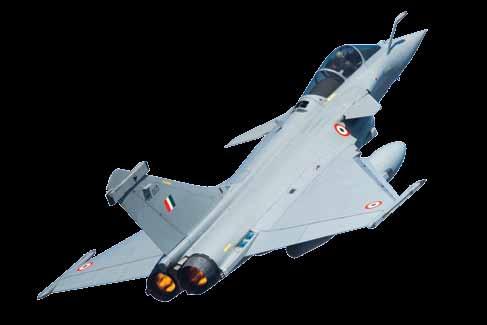
Deficiency also exists in the Force Multipliers. Force-Multipliers are important for any Air Force for gaining air superiority. An Air Force must have the capability to assemble a potent offensive or defensive package at the points of decision in time and space to achieve its strategic goals. These force multiplier aircraft play a pivotal role in providing an asymmetric advantage at operational, strategic and tactical levels of war.
Airborne Early Warning and Control Systems (AWACS) and Flight Refueling aircraft (FRA) falls in the category of force Multipliers. To handle a two war front, the IAF needs 18 AWACS platforms and at least six more FRA.
By Air Vice MArshAl sAnjAy BhAtnAgAr (retd)IAF however has only three Netra AEW&C (developed on Embraer EMB 145) and three AWACS developed on IL-76 platform with EL/W-2090 Phalcon radar by Israel Aerospace. On September 2021 the Cabinet Committee’s Security has cleared `11,000 crore projects for DRDO to develop six new AEW&C systems on the six old A320 aircraft bought from Air India. These are presently undergoing refurbishment by Airbus, Spain. Once they arrive they will have to be fitted with DRDO developed electronic mission equipment, followed by various integration qualification, testing and evaluation to be certified as flight worthy. In the best case scenario, the whole process would take at least six to eight years.
The next Force multiplier, FRA extends the fighter aircraft range of operation, thereby making strategic targets accessible. The IAF is currently operating six IL-78 aircraft, inducted in 2003. The aircraft serviceability is known to be under 50 per cent.
To address the FRA shortfall, the IAF has been trying to acquire six mid-air refuellers since 2007 with no success due to issues related to Life Cycle Costs and processes. IAF has now embarked on its long term solution to acquire at least six FRAs that will have reduced maintenance related down time and low operating cost. The Airbus A330 MRTT, the IL-78 and the Boeing KC-46A seem to be contenders. Besides, under its short term plan, IAF is also seeking reliable partners for leasing at least two to three FRAs from the West.
Media sources have reported that China’s People’s Liberation Army Air Force (PLAAF) has nearly 80 combat squadrons. China is investing heavily into aerospace Research and Development and continues to modernise its fleet with indigenously built aircraft and Unmanned Aerial Vehicles. They claim to have nearly 50 J-20 (fifth generation fighter) already operational and have plans to have 200 by 2027. Other modern fighters include 24 Su-35 and more than 500 J-10s.
China has been bolstering its air power by adding new infrastructure at its air bases in Tibet region. The IAF has been operationally forced to scramble its fighter aircraft to counter PLAAF air violations close to LAC.
The growing imbalance vis-à-vis China is very evident. The issue of bridging the yawning gap in capability must be addressed on priority so that the IAF retains its combat edge. In view of the above, the Government needs to expedite inductions and take up urgent procurement to mitigate the critical shortages of fighter aircraft and force multipliers. SP



Reaching a maximum cruise speed of Mach 0.80, carrying 26t, and operating at a ceiling of 36,000ft, the twin turbofan-powered C-390 Millennium delivers outstanding tactical performance with strategic effect. For the crew, new innovations including the fully automated cargo handling and aerial systems that reduce workload and improve productivity. Already proven in service with the Brazilian Air Force and, with contracts signed by the Portuguese and Hungarian Air Forces, the multi-mission C-390 takes mobility to the next level even in the most challenging environments.
#C390UnbeatableCombination embraerds.com
Photographic record made during the unpaved runway test campaign. C-390 MILLENNIUM